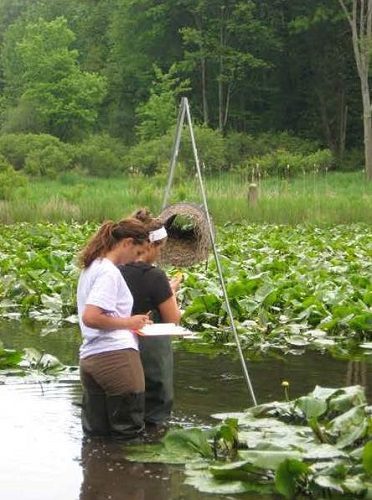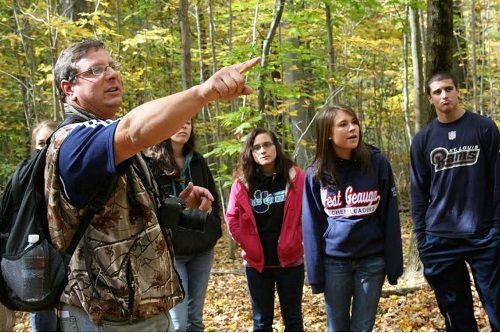There are lots of benefits for students learning outdoors and connecting with nature. But many teachers are uncomfortable with the idea or hesitant to try it out. I asked a few Minnesota teachers – one preschool, one elementary, two secondary – to give me their “Top Ten” tips for colleagues who have never taught outside.

High School
Here are ten tips from Stanley Mikles, science teacher, Hill City Secondary School in northern Minnesota:
- Train your students to be in the forest/swamp/field/school yard. This process begins my first day of each semester. We advance outdoors by short steps. It takes some time to build respect and trust.
- Every excursion should have a well-defined purpose and well-defined expected outcomes. Having said that, the purpose of the excursion does not necessarily have to fit with the topic you are studying. Sometimes surprises open the doors for discovery!
- Safety is discussed, not dictated. In 18 years, I have never had a serious injury in my classes.
- Make sure students have the necessary clothing for the environment and the weather. Over the years, students have abandoned coats, gloves, hats, and boots to a point where I have a room full of the stuff. As winter comes, I remind them to get ready. We can’t go if even one kid shows up in a t-shirt and shorts. That’s when I pull from my jacket and boot collection.
- Be motivated for the work at hand. I find that if I am having a “bad day” and I let it show, it rubs off. On the other hand, my passion for the topic builds passion in my students.
- Establish a rally point (central meeting place) for each event.
- Use a signal to meet at the rally point. I use a cow call that kids can hear for miles.
- Field journals are required. No journal entries for the day equals a zero.
- Teams are good, sometimes. I have to know my students to make that call.
- Make accommodations for less capable students. Arrange for a paraprofessional to escort students with special needs. Brief your paraprofessionals on the what, why, where, when and how’s.
Middle School

Here are ten tips from Mark Studer, Bemidji Middle School in Minnesota:
- Have the kids establish the outdoor “rules” that they will live by for the year the first week and have all agree to them (thumbs up is fine)
- If you need to warn more than once about behavior – just send them in to sit in the classroom. Don’t get mad – just tell them you are sorry but they are going to have to go in – and continue with your class. Kids respect that and are much more likely to give you their “undivided” attention once someone has been sent in. And I follow up with a short phone call to the parent to chat with them.
- Have them bring their science notebooks and always have something for them to do in the science notebook, whether it is a journal entry, or notes on something you are talking about or a sketch, or other observation.
- When I am speaking, I tell them to huddle and to make sure they are not any more than “two deep” around me. Works fairly well.
- I take time for “teachable moments” when we run into something outside that is unexpected like the walking stick (insect) that a student found while we were sitting discussing ecology – we all got a look at him and discussed the term “mimicry.”
- Teach them how to observe with “soft eyes” looking not just in a specific spot but focusing on everything at the same time. Helps them to see movement and the bigger picture.
- For an initial trip outdoors in the fall, position them along a trail so they can’t see each other and have them sit and observe with all their senses their surroundings while they are perfectly still.
- I carry a small backpack with me when I go out – I carry an anemometer (wind meter), thermometer, extra pencils, rulers, first aid pack, clipboard, magnifying lens, water bottle, candy, field guides, binoculars, and anything else I think might be useful.
- Don’t be discouraged if every time you take your kids out things don’t go perfectly. Reflect on the event and make a few notes on how to make it better the next time. Then go out again!
- Take your students out in the winter as well. Just do it.
More Tips for Teaching Outside
Attend a PLT workshop and become comfortable teaching outdoors – in urban, suburban, and rural areas.
Review these tips from early childhood and elementary teachers – they may be useful too!



2 comments on “Top Ten Tips for Teaching Outside – Middle and High School”
Thanks for the good tips for teaching outdoors. I teach at Yellow Medicine East middle school/high school and we have an outdoor wildlife area that is underutilized. I teach art and am looking for ideas for connecting students to learning and the outdoors.
That’s wonderful to hear! For a selection of stories and tips from other teachers who have implemented similar projects at their school, check out https://www.plt.org/teacher-stories/ and https://www.plt.org/resources/educator-tips/. Your PLT Coordinator in Minnesota can also be a great resource for you, see https://www.plt.org/network/minnesota/